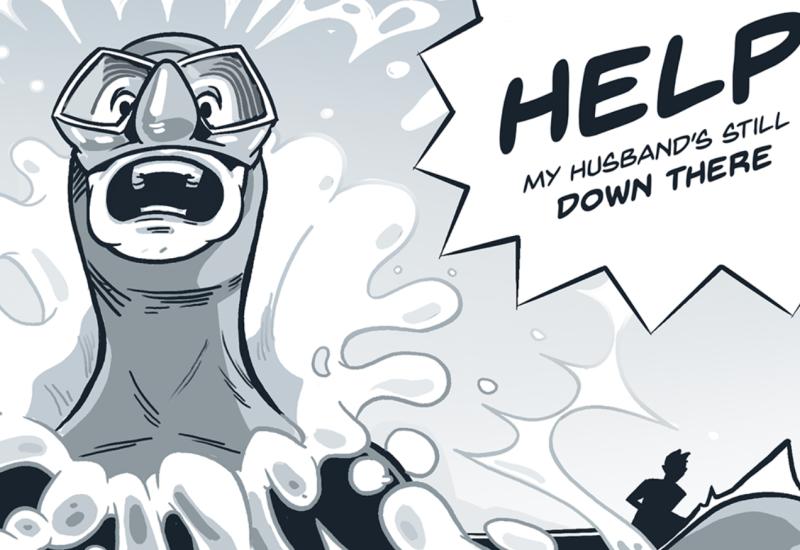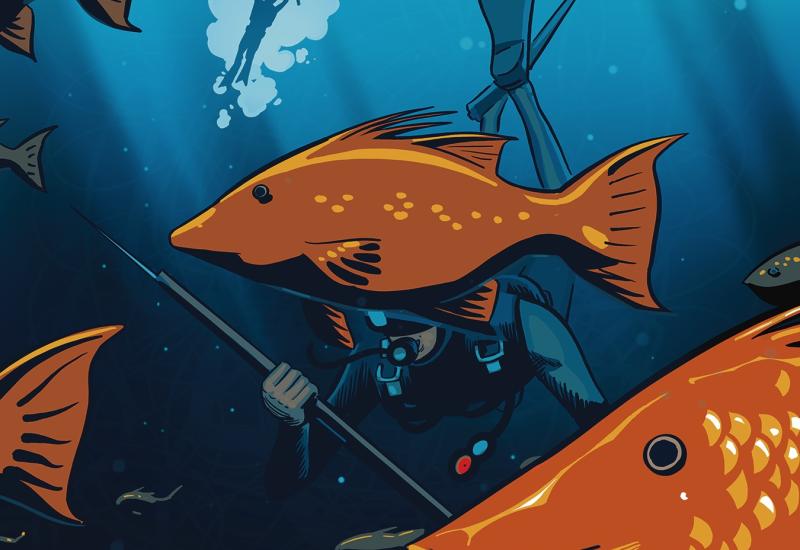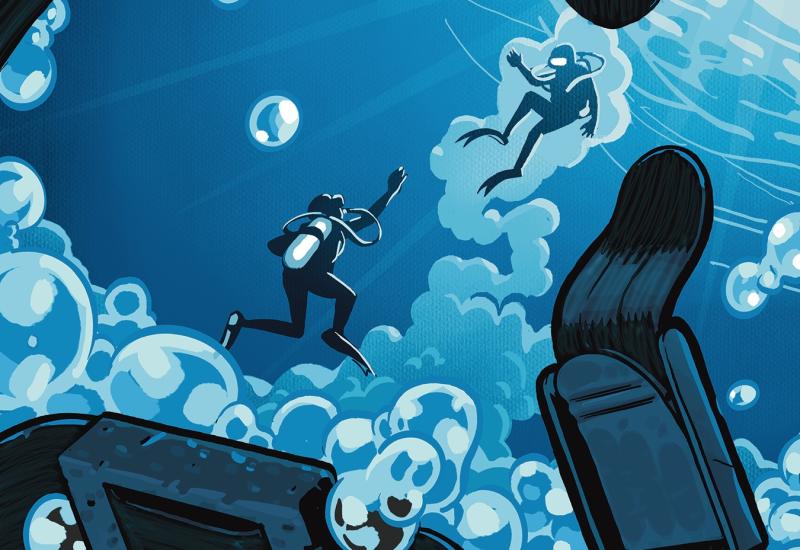The Unmanned Dive Boat
April 2003
A businessman in his early 40s, Bill had just purchased his first blue-water vessel — a 42-foot sportfishing boat. For the boat's inaugural trip, Bill decided to cruise to the warm waters of the Florida Keys to dive for lobsters. His girlfriend, Carol, a diver in her early 30s, accompanied Bill on the trip.
The Dive
Bill pulled his new boat into the calm waters just south of the protected area of John Pennekamp State Park and set an anchor to moor the vessel. The divers had already made two dives that day, and around 1:30 p.m., they set off for dive number three.
Bill and Carol descended through the clear 82-degree water, and hunted in the nooks and crannies of the shallow reef for well over an hour. Returning from a depth of 45 feet, the divers swam over the reef, trying to find their boat's anchor. Unfortunately, it was nowhere to be found. The divers surfaced to find an empty ocean and no boat in sight.
The Accident
Because they were diving in warm water, both divers were wearing only bathing suits and T-shirts. Even in 82-degree water, they soon became hypothermic. To make matters worse, the wind picked up, and a slight chop made it difficult for the divers to keep their heads above water. The divers occasionally saw passing boats, but they had no way of signaling, so they continued to drift helplessly north on the current. As the sun began to set, Bill removed his fin and tried to use it as a signaling device.
The Rescue
Soon after Bill removed his fin, a boat heading out for a twilight dive spotted a speck of yellow on the southern horizon. Looking through binoculars, the captain realized that two divers were drifting in the open ocean with no vessel in sight.
Fifteen minutes later, the boat pulled alongside the two hypothermic divers. Bill was able to board the vessel with assistance, but Carol had difficulty even keeping her head above water. She had swallowed so much salt water that she was nauseated. The nausea, coupled with her hypothermia, made her unable to assist with her own rescue. When the rescuing divers removed her gear, they were surprised to find her integrated weights still in the BC and a bag of lobster dangling from a D-ring. Once Bill and Carol were safely on board, the other divers on the boat gave them towels, dry clothes and drinks to rehydrate them. Both divers survived with only emotional trauma for their nearly disastrous lack of planning. Bill's vessel was later located by the Coast Guard, drifting in the deep water of the Gulf Stream.
Analysis
Bill made several mistakes. First, he wasn't trained to handle a boat of that size. If he had attended a safe-boating program, he wouldn't have made the second mistake — leaving his vessel unattended while he went diving. It's unclear why the boat broke its anchorage, but a number of scenarios are possible. A wind or current shift could have pulled the boat in a different direction, breaking the anchor's set. The anchor line could have been too short, or the line might have been cut on the coral reef where Bill anchored irresponsibly.
Both divers wore inadequate exposure protection. In fact, Carol had signaled that she was already chilled before they attempted to return to the exit point. Neither diver carried any type of signaling device.
Most troubling, in light of Carol's inability to keep her head above the water, neither Bill nor Carol jettisoned their weights or discarded their lobster bags even after nearly four hours adrift. Finally, Bill failed to give a dive plan or a float plan to someone on shore. Had the divers not been spotted by the passing charter vessel, they could have drifted for days before anyone realized they were missing.
Lessons for Life
-
Get proper training before operating any dive vessel.
-
Always file a float plan or a dive plan with a responsible family member or friend who will remain on shore.
-
Never leave a dive boat unattended. The person left onboard must be capable of operating the vessel.
-
Always wear enough thermal protection to stay warm at least through the course of your planned dive. You never know when your stay in the water may be extended, possibly dramatically.
-
No matter how calm conditions are when you enter the water, every open-ocean dive has the potential to separate the diver from the boat. Always carry visual and audible signaling devices.
-
When in trouble on the surface, immediately jettison your weights and any other unnecessary equipment. Your life is always worth more than your gear or your catch.
April 2003
A businessman in his early 40s, Bill had just purchased his first blue-water vessel — a 42-foot sportfishing boat. For the boat's inaugural trip, Bill decided to cruise to the warm waters of the Florida Keys to dive for lobsters. His girlfriend, Carol, a diver in her early 30s, accompanied Bill on the trip.
The Dive
Bill pulled his new boat into the calm waters just south of the protected area of John Pennekamp State Park and set an anchor to moor the vessel. The divers had already made two dives that day, and around 1:30 p.m., they set off for dive number three.
Bill and Carol descended through the clear 82-degree water, and hunted in the nooks and crannies of the shallow reef for well over an hour. Returning from a depth of 45 feet, the divers swam over the reef, trying to find their boat's anchor. Unfortunately, it was nowhere to be found. The divers surfaced to find an empty ocean and no boat in sight.
The Accident
Because they were diving in warm water, both divers were wearing only bathing suits and T-shirts. Even in 82-degree water, they soon became hypothermic. To make matters worse, the wind picked up, and a slight chop made it difficult for the divers to keep their heads above water. The divers occasionally saw passing boats, but they had no way of signaling, so they continued to drift helplessly north on the current. As the sun began to set, Bill removed his fin and tried to use it as a signaling device.
The Rescue
Soon after Bill removed his fin, a boat heading out for a twilight dive spotted a speck of yellow on the southern horizon. Looking through binoculars, the captain realized that two divers were drifting in the open ocean with no vessel in sight.
Fifteen minutes later, the boat pulled alongside the two hypothermic divers. Bill was able to board the vessel with assistance, but Carol had difficulty even keeping her head above water. She had swallowed so much salt water that she was nauseated. The nausea, coupled with her hypothermia, made her unable to assist with her own rescue. When the rescuing divers removed her gear, they were surprised to find her integrated weights still in the BC and a bag of lobster dangling from a D-ring. Once Bill and Carol were safely on board, the other divers on the boat gave them towels, dry clothes and drinks to rehydrate them. Both divers survived with only emotional trauma for their nearly disastrous lack of planning. Bill's vessel was later located by the Coast Guard, drifting in the deep water of the Gulf Stream.
Analysis
Bill made several mistakes. First, he wasn't trained to handle a boat of that size. If he had attended a safe-boating program, he wouldn't have made the second mistake — leaving his vessel unattended while he went diving. It's unclear why the boat broke its anchorage, but a number of scenarios are possible. A wind or current shift could have pulled the boat in a different direction, breaking the anchor's set. The anchor line could have been too short, or the line might have been cut on the coral reef where Bill anchored irresponsibly.
Both divers wore inadequate exposure protection. In fact, Carol had signaled that she was already chilled before they attempted to return to the exit point. Neither diver carried any type of signaling device.
Most troubling, in light of Carol's inability to keep her head above the water, neither Bill nor Carol jettisoned their weights or discarded their lobster bags even after nearly four hours adrift. Finally, Bill failed to give a dive plan or a float plan to someone on shore. Had the divers not been spotted by the passing charter vessel, they could have drifted for days before anyone realized they were missing.
Lessons for Life
Get proper training before operating any dive vessel.
Always file a float plan or a dive plan with a responsible family member or friend who will remain on shore.
Never leave a dive boat unattended. The person left onboard must be capable of operating the vessel.
Always wear enough thermal protection to stay warm at least through the course of your planned dive. You never know when your stay in the water may be extended, possibly dramatically.
No matter how calm conditions are when you enter the water, every open-ocean dive has the potential to separate the diver from the boat. Always carry visual and audible signaling devices.
When in trouble on the surface, immediately jettison your weights and any other unnecessary equipment. Your life is always worth more than your gear or your catch.










